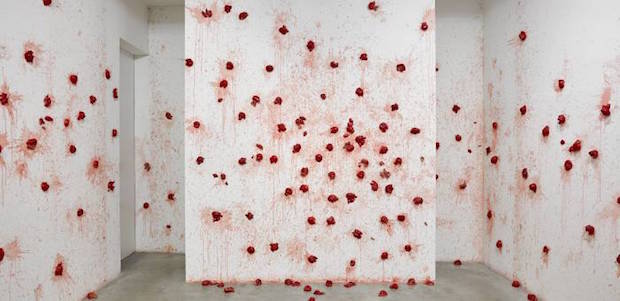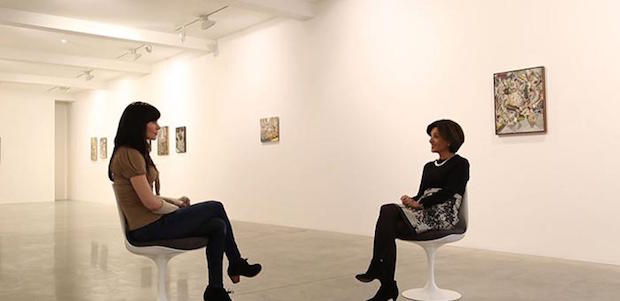Killer Curator: Ziba Ardalan
SERIES: We ask the best curators in the world what it takes to make it in the cutthroat contemporary art scene

But how does she know when she's found someone special? 'When I tell myself, ‘Wait a minute!’, Ardalan laughs.
Nestled behind Old Street, the non-profit gallery Parasol unit foundation for contemporary art shares its Victorian furniture factory space with another influential woman in the artworld, gallerist Victoria Miro.
Most recently the spotlight fell on Cuban duo Los Carpinteros, the feisty art collective who had a positive reaction for their humorous and political show filled with smashed tomatoes, melted drum kits and raucous backward carnivals.
It was in 2008 that Parasol unit first appeared on our radars, with a fantastic show of Turner Prize nominee Darren Almond which prompted funding from the Arts Council. But the gallery is largely financially independent, giving it a special freedom to host exhibitions beyond the buzzy blockbusters.

Los Carpinteros, 'Tomates' (installation view), 2013. Real tomatoes and watercolour splash, porcelain, dimensions variable. © Los Carpinteros Photo: Jack Hems. Courtesy of Parasol unit
Ardalan first came to London in 2000, after splitting her time between New York and Zurich, with a curiously scientific background.
"Having had the good fortune to earn a PhD in physical chemistry from the University of Geneva before studying art history, I feel my understanding of the world has been quite enriched'. Her inspiration comes from Harold Szeeman, the groundbreaking Swiss curator who really made the profession into an art form. For Ardalan, it was 'his thoughtfulness, generosity to all and devotion to artists which were simply exemplary.'
Now we count Ardalan as one of these star curators that has the power to make or break an artist's career. But Ardalan fiercely rejects the notion that curators have more influence than artists:
"curating has always been an art in itself. But I like to think that artists as the creators are far more important than curators. Art can exist without curators, but curators cannot exist without the art."
"The relationship," she says "between artists and curators has changed considerably. In the past, artists and curators worked closely as a team to put together an exhibition. Nowadays they each head their own ‘enterprise’ and it is almost inevitable that each party will want to play a more prominent role."
What does she think about this way of doing things?
"Personally, I'm not in favour of such a model and am adamant about keeping a lively and thriving working relationship with each artist as we prepare for an exhibition at Parasol unit. Every artist uniquely enriches my existence and I am always grateful for the experience of getting to know them and the intricacies of their work."

Katy Moran artist in conversation with Ziba Ardalan, Parasol unit
Perhaps that is Ardalan's special power, her unique sincerity and commitment to nurturing young artistic talent: "I have no problem with my public role. When one puts up one’s head and makes a statement, one is of course accountable for the result. It is hugely satisfying to express oneself and hopefully make a difference"
Ardalan of course also possesses a discerning eye for new names, paying particular attention to artists that "respond to their time, environment, society and, frequently, also anticipate the future. And I pay special attention to the work of artists who assimilate developments in communication technology, science and biotechnology into their creative process."
If you want to play the curatorial game, Ardalan recommends keeping your eye on artists who are moving 'beyond art for art's sake to provide a focused commentary on politics and changes in society'.

Bharti Kher: 'The skin speaks a language not its own', 2006. Bindis on fibreglass Life size, 142 x 456.2 x 195 cm (56 x 179½ x 76¾ in). Private collection, Switzerland. Photography: Bartholomew/Netphotograph. © Bharti Kher
It was her first exhibition at the Whitney Museum of American Art in 1984, after finishing her Masters degree in Art History at Columbia University, New York, when Ardalan found her feet. "My first show was actually my most challenging. I intended the exhibition to follow the development of Winslow Homer’s works through his seascapes within a time-span of forty years."
Homer, for those that don't know, is one of the most admired American artists of the late nineteenth and early twentieth centuries, whose work is jostled for by museums and collectors around the world.
"As a young curator new to the field it was a huge challenge for me to convince institutions and collectors to lend their work to the show. Many of Homer’s paintings belong to small institutions throughout New England. I can only tell you that it was more challenging to drive to all those places than to convince the lenders to lend their works to the exhibition. Happily, the result was stunning!"
The Whitney has had a lasting effect on Ardalan. She cites her favourite show as the late Richard Marshall's Ellsworth Kelly retrospective of hard-edged bright paintings. "It was simply fabulous and to this day its beauty and luminosity have stayed in my mind."
But it's not just curating that's changed, how we view art has evolved with shows on screen at the cinema and live twitter tours bringing the biggest exhibitions in town to your living room. "One cannot stop technological advances'," Ardalan says, "besides which, we are already pretty much controlled by them. The best we can do is to work with them and use them to our advantage.'
While riding the digital wave, Ardalan is also a purist: 'I appreciate the wider access and education these developments can provide, but for as long as our species remains fundamentally human, I believe art is most rewardingly experienced in person.'
And the cardinal sin of a curator? Not to listen enough to the artist.
You can catch Parasol unit's new show Katrín Sigurðardóttir: Supra Terram from 12th June.






